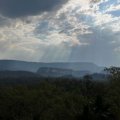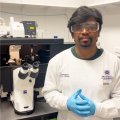Textiles and wearable art from Papua New Guinea form the basis of a University of Queensland art exhibition currently on display.
Kibung: Textiles from graduates of the National Arts School, Papua New Guinea focuses on textile graduates from the school during the 1980s and their subsequent careers.
“The 1980s were a particularly vital era of creative endeavour in PNG and the National Art School made an enormous contribution to areas of creative practice, particularly in textile design,” said co-curator and University of Queensland Art Museum Director Ross Searle.
More than 75 textiles and wearable items are on display from now until August 17 from 10am–4pm daily at the Customs House Art Gallery, 399 Queen St, Brisbane city.
“The exhibition is a documentation of almost 20 years of struggle, invention and wonderful achievement,” said co-curator Jill Kinnear, a Queensland-based artist and textile designer who taught at the National Arts School of Papua New Guinea from 1986- to 1989.
“Textile design has been used as a political tool, propaganda, even a conveyor of secret messages, but ultimately its most powerful role is its declaration of national cultural identity and narrative.
“Since graduating many of the artists have moved onto further study and developed successful individual careers in teaching and the arts, some could not be traced, and sadly some have passed away.”
Ms Kinnear said the exhibition was a meeting or reunion of the artists and their work with the word kibung meaning an official meeting in Melanesian Pidgin
Some of the work on display includes Wendi Choulai’s 105 skirt of raffia and plastic bags, part of a 1996 swimwear commission for swimwear company Speedo; Ben Mele’s 1989 Air Niugini uniforms; and Henry Iyaro’s Tapa cloth design used for the 1994 Commonwealth Games uniforms.
The exhibition also includes a hand-printed folding screen (can be re-word this?) with Faces design by Solomon Kavo and Oksy Okae’s carpet design inspired by a hairy snail found in the PNG Highlands.
Barleyde Katit’s fabrics inspired by shields and masks from the Papuan Gulf, the Sepik and the Maring tribe of Madang are also on display, as are fabric designs by Philip Brimpier featuring war shields, canoes, masks and PNG wildlife.
Media: For more information contact Mr Searle (telephone 07 3365 7952), Customs House (telephone 07 3365 8999) or Joanne van Zeeland at UQ Communications (telephone 07 3365 2619).
.jpg)



